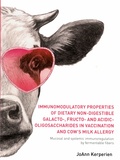Immunomodulatory properties of dietary non-digestible galacto-, fructo- and acidic-oligosaccharides in vaccination and cow’s milk allergy
Mucosal and systemic immunoregulation by oligosaccharides

Kerperien, JoAnn
- Promoter:
- Prof.dr. J. (Johan) Garssen
- Co-promoter:
- Dr. L.E.M. (Linette) Willemsen & dr. L.M.J. (Leon) Knippels
- Research group:
- Garssen
- Date:
- June 17, 2019
- Time:
- 14:30 h
Summary
The prevalence of allergic diseases in western countries is increasing. One of the first allergies to develop early in life, is cow’s milk allergy (CMA). Oral tolerance is generated against harmless food proteins such as cow’s milk proteins, leading to systemic immunological non-responsiveness. However, one to three percent of children generate a Th2 driven immune response against these proteins and develop CMA. Upon oral ingestion of the culprit food symptoms range from gastro-intestinal and behavioral changes, to cutaneous and respiratory reaction and even anaphylaxis may occur. Most children outgrow CMA, however they still are more susceptible to develop other allergies later in life. Currently there is no cure for cow’s milk allergy. Therefore, it is important to study ways aiming to prevent or treat CMA. Non-digestible oligosaccharides (NDO) present in human milk, have a beneficiary influence on the intestinal microbiome and the immune system. Cow’s milk-based formula is nowadays supplemented with NDO mimicking some structural and functional aspects of human-milk NDO. In the current studies, the CMA preventive and treatment effects of three different enzymatically produced or isolated NDO, namely short-chain Galacto oligosaccharides (G), long-chain Fructo oligosaccharides (F) and pectin derived Acidic oligosaccharides (A) were examined. These three NDO were used singularly or in combination (GF or GFA) to investigate whether CMA could be diminished in a murine model of CMA. The supplemented diets were fed two weeks prior and during the whole sensitization and challenge phase (prevention) or only during the challenge phase (treatment). Both GF or GFA were effective in reducing the CMA symptoms only in a preventive setting. GF modulated immune markers in the intestinal mucosa, downregulating Th2 related GATA3 expression, while GFA enhanced Th1 related Tbet expression, the expression of regulatory cytokines IL10 and TGFβ and the frequency of intestinal FoxP3 positive regulatory T-cells. The contribution of IL10 and TGFβ in the CMA protective effect of GFA were further investigated by using antibodies that block the IL10 receptor or TGFβ in vivo. This inhibition abrogated the preventive effect of GFA on CMA symptoms completely. Beyond the effects of NDO also dietary supplementation with vitamin D or vitamin A was studied since these are known for their immunoregulatory capacities. Vitamin D did not add to the preventive effect of GFA, whereas vitamin A supported GFA in its capacity to reduce CMA symptoms. Since GFA supports the immune system, it was also studied if GFA affects the vaccination response in mice. Indeed, GFA was found to enhance the influenza vaccination response via inhibition of a specific regulatory T cell subtype, which normally downregulates the Th1 cell population. These studies help to understand the mechanisms by which dietary supplementation with GFA (1 w/w%) influences the immune system leading to reduced CMA development and boosting the influenza vaccination response. These results pave the way to further optimize NDOs for immune support in early life, which could contribute to a lower risk to develop CMA.